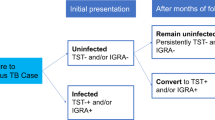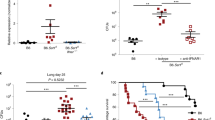Abstract
Tuberculosis remains a significant public health problem: one-third of the human population is infected with virulent Mycobacterium tuberculosis (MTB) and 10% of those are at risk of developing tuberculosis during their lifetime. In both humans and experimental animal models, genetic variation among infected individuals contributes to the outcome of infection. However, in immunocompetent individuals (the majority of patients), genetic determinants of susceptibility to tuberculosis remain largely unknown. Mouse models of MTB infection, allowing control of exposure and other potential environmental contributors, have proven extremely useful for examining this genetic component. In a cross of C3HeB/FeJ (susceptible) by C57BL/6J (resistant) inbred mouse strains, we have previously identified one major genetic locus, sst1, the susceptible allele of which did not confer an overt immunodeficiency, but rather specifically affected progression of lung tuberculosis. Having generated and tested the sst1 congenic strains, we have observed that this locus only partially explained the difference in susceptibility of the parental strains to MTB. We now present further studies controlling for the effect of the sst1, identify four additional tuberculosis susceptibility loci and characterize their effects by testing an independent cross, knockout or congenic mice.
This is a preview of subscription content, access via your institution
Access options
Subscribe to this journal
Receive 6 digital issues and online access to articles
$119.00 per year
only $19.83 per issue
Buy this article
- Purchase on Springer Link
- Instant access to full article PDF
Prices may be subject to local taxes which are calculated during checkout



Similar content being viewed by others
References
Bleed D, Dye C, Raviglione MC . Dynamics and control of the global tuberculosis epidemic. Curr Opin Pulm Med 2000; 6: 174–179.
Casanova JL, Abel L . Genetic dissection of immunity to mycobacteria: the human model. Annu Rev Immunol 2002; 20: 581–620.
Hill AV . The genomics and genetics of human infectious disease susceptibility. Annu Rev Genomics Hum Genet 2001; 2: 373–400.
Lynch CJ, Pierce-Chase CH, Dubos R . A genetic study of susceptibility to experimental tuberculosis in mice infected with mammalian tubercle bacilli. J Exp Med 1965; 121: 1051–1070.
Lurie MB, Zappasodi P, Dannenberg Jr AM, Weiss GH . On the mechanism of genetic resistance to tuberculosis and its mode of inheritance. Am J Hum Genet 1952; 4: 302–314.
Musa SA, Kim Y, Hashim R, Wang GZ, Dimmer C, Smith DW . Response of inbred mice to aerosol challenge with Mycobacterium tuberculosis. Infect Immun 1987; 55: 1862–1866.
Medina E, North RJ . Resistance ranking of some common inbred mouse strains to Mycobacterium tuberculosis and relationship to major histocompatibility complex haplotype and Nramp1 genotype. Immunology 1998; 93: 270–274.
North RJ, Jung YJ . Immunity to tuberculosis. Annu Rev Immunol 2004; 22: 599–623.
Brett S, Orrell JM, Swanson Beck J, Ivanyi J . Influence of H-2 genes on growth of Mycobacterium tuberculosis in the lungs of chronically infected mice. Immunology 1992; 76: 129–132.
Chackerian AA, Perera TV, Behar SM . Gamma interferon-producing CD4+ T lymphocytes in the lung correlate with resistance to infection with Mycobacterium tuberculosis. Infect Immun 2001; 69: 2666–2674.
Kamath AB, Alt J, Debbabi H, Behar SM . Toll-like receptor 4-defective C3H/HeJ mice are not more susceptible than other C3H substrains to infection with Mycobacterium tuberculosis. Infect Immun 2003; 71: 4112–4118.
Kramnik I, Demant P, Bloom BB . Susceptibility to tuberculosis as a complex genetic trait: analysis using recombinant congenic strains of mice. Novartis Found Symp 1998; 217: 120–131.
Kramnik I, Dietrich WF, Demant P, Bloom BR . Genetic control of resistance to experimental infection with virulent Mycobacterium tuberculosis. Proc Natl Acad Sci USA 2000; 97: 8560–8565.
Pan H, Yan BS, Rojas M, Shebzukhov YV, Zhou H, Kobzik L et al. Ipr1 gene mediates innate immunity to tuberculosis. Nature 2005; 434: 767–772.
Vidal SM, Malo D, Vogan K, Skamene E, Gros P . Natural resistance to infection with intracellular parasites: isolation of a candidate for Bcg. Cell 1993; 73: 469–485.
Kruglyak L, Lander ES . A nonparametric approach for mapping quantitative trait loci. Genetics 1995; 139: 1421–1428.
Symons RC, Daly MJ, Fridlyand J, Speed TP, Cook WD, Gerondakis S et al. Multiple genetic loci modify susceptibility to plasmacytoma-related morbidity in E(mu)-v-abl transgenic mice. Proc Natl Acad Sci USA 2002; 99: 11299–11304.
Parsons M, Herzenberg LA, Stall AM, Herzenberg LA . Chapter 97. Mouse immunoglobulin allotypes. In: Weir DM (ed.) Handbook of Experimental Immunology. Blackwell Scientific Publ.: Oxford, 1986, pp. 97.1–97.17.
Wade CM, Kulbokas III EJ, Kirby AW, Zody MC, Mullikin JC, Lander ES et al. The mosaic structure of variation in the laboratory mouse genome. Nature 2002; 420: 574–578.
Kitamura D, Roes J, Kuhn R, Rajewsky K . A B cell-deficient mouse by targeted disruption of the membrane exon of the immunoglobulin mu chain gene. Nature 1991; 350: 423–426.
Turner J, Frank AA, Brooks JV, Gonzalez-Juarrero M, Orme IM . The progression of chronic tuberculosis in the mouse does not require the participation of B lymphocytes or interleukin-4. Exp Gerontol 2001; 36: 537–545.
Vordermeier HM, Venkataprasad N, Harris DP, Ivanyi J . Increase of tuberculous infection in the organs of B cell-deficient mice. Clin Exp Immunol 1996; 106: 312–316.
Bosio CM, Gardner D, Elkins KL . Infection of B cell-deficient mice with CDC 1551, a clinical isolate of Mycobacterium tuberculosis: delay in dissemination and development of lung pathology. J Immunol 2000; 164: 6417–6425.
Johnson CM, Cooper AM, Frank AA, Bonorino CB, Wysoki LJ, Orme IM . Mycobacterium tuberculosis aerogenic rechallenge infections in B cell-deficient mice. Tuberc Lung Dis 1997; 78: 257–261.
Huygen K, Ljungqvist L, ten Berg R, Van Vooren JP . Repertoires of antibodies to culture filtrate antigens in different mouse strains infected with Mycobacterium bovis BCG. Infect Immun 1990; 58: 2192–2197.
Brett SJ, Ivanyi J . Genetic influences on the immune repertoire following tuberculous infection in mice. Immunology 1990; 71: 113–119.
Bosio CM, Elkins KL . Susceptibility to secondary Francisella tularensis live vaccine strain infection in B-cell-deficient mice is associated with neutrophilia but not with defects in specific T-cell-mediated immunity. Infect Immun 2001; 69: 194–203.
Schrier DJ, Sternick JL, Allen EM, Moore VL . Genetic basis of BCG-induced suppression of delayed hypersensitivity. Nature 1981; 289: 405–407.
Schrier DJ, Sternick JL, Allen EM, Moore VL . Immunogenetics of BCG-induced anergy in mice: control by genes linked to the Igh complex. J Immunol 1982; 128: 1466–1469.
Goldfeld AE, Delgado JC, Thim S, Bozon MV, Uglialoro AM, Turbay D et al. Association of an HLA-DQ allele with clinical tuberculosis. JAMA 1998; 279: 226–228.
Apt AS, Avdienko VG, Nikonenko BV, Kramnik IB, Moroz AM, Skamene E . Distinct H-2 complex control of mortality, and immune responses to tuberculosis infection in virgin and BCG-vaccinated mice. Clin Exp Immunol 1993; 94: 322–329.
Sanchez F, Radaeva TV, Nikonenko BV, Persson AS, Sengul S, Schalling M et al. Multigenic control of disease severity after virulent Mycobacterium tuberculosis infection in mice. Infect Immun 2003; 71: 126–131.
Asherson GL, Dieli F, Gautam Y, Siew LK, Zembala M . Major histocompatibility complex regulation of the class of the immune response: the H-2d haplotype determines poor interferon-gamma response to several antigens. Eur J Immunol 1990; 20: 1305–1310.
Kamath AB, Alt J, Debbabi H, Taylor C, Behar SM . The major histocompatibility complex haplotype affects T-cell recognition of mycobacterial antigens but not resistance to Mycobacterium tuberculosis in C3H mice. Infect Immun 2004; 72: 6790–6798.
Algood HM, Lin PL, Flynn JL . Tumor necrosis factor and chemokine interactions in the formation and maintenance of granulomas in tuberculosis. Clin Infect Dis 2005; 41 (Suppl 3): S189–S193.
Kahler AK, Persson AS, Sanchez F, Kallstrom H, Apt AS, Schurr E et al. A new coding mutation in the Tnf-alpha leader sequence in tuberculosis-sensitive I/St mice causes higher secretion levels of soluble TNF-alpha. Genes Immun 2005; 6: 620–627.
Skamene E, Schurr E, Gros P . Infection genomics: Nramp1 as a major determinant of natural resistance to intracellular infections. Annu Rev Med 1998; 49: 275–287.
North RJ, LaCourse R, Ryan L, Gros P . Consequence of Nramp1 deletion to Mycobacterium tuberculosis infection in mice. Infect Immun 1999; 67: 5811–5814.
Malik S, Abel L, Tooker H, Poon A, Simkin L, Girard M et al. Alleles of the NRAMP1 gene are risk factors for pediatric tuberculosis disease. Proc Natl Acad Sci USA 2005; 102: 12183–12188.
Bellamy R, Ruwende C, Corrah T, McAdam KP, Whittle HC, Hill AV . Variations in the NRAMP1 gene and susceptibility to tuberculosis in West Africans. N Engl J Med 1998; 338: 640–644.
Vidal SM, Pinner E, Lepage P, Gauthier S, Gros P . Natural resistance to intracellular infections: Nramp1 encodes a membrane phosphoglycoprotein absent in macrophages from susceptible (Nramp1 D169) mouse strains. J Immunol 1996; 157: 3559–3568.
Mitsos LM, Cardon LR, Fortin A, Ryan L, LaCourse R, North RJ et al. Genetic control of susceptibility to infection with Mycobacterium tuberculosis in mice. Genes Immun 2000; 1: 467–477.
Mitsos LM, Cardon LR, Ryan L, LaCourse R, North RJ, Gros P . Susceptibility to tuberculosis: a locus on mouse chromosome 19 (Trl-4) regulates Mycobacterium tuberculosis replication in the lungs. Proc Natl Acad Sci USA 2003; 100: 6610–6615.
Kramnik I, Boyartchuk V . Immunity to intracellular pathogens as a complex genetic trait. Curr Opin Microbiol 2002; 5: 111–117.
Casanova JL, Abel L . Inborn errors of immunity to infection: the rule rather than the exception. J Exp Med 2005; 202: 197–201.
Laird PW, Zijderveld A, Linders K, Rudnicki MA, Jaenisch R, Berns A . Simplified mammalian DNA isolation procedure. Nucleic Acids Res 1991; 19: 4293.
Acknowledgements
We gratefully acknowledge Marshfield Center for Medical Genetics at the Marshfield Medical Research Foundation (Marshfield, WI, USA) for performing the whole genome scan. We are also grateful to Ilona Breiterene and Christina Mottley for expert technical assistance. This work was supported by NIH HLBI (Grant R01 HL 059836 to IK).
Author information
Authors and Affiliations
Corresponding author
Additional information
Supplementary Information accompanies the paper on Genes and Immunity website (http://www.nature.com/gene)
Rights and permissions
About this article
Cite this article
Yan, BS., Kirby, A., Shebzukhov, Y. et al. Genetic architecture of tuberculosis resistance in a mouse model of infection. Genes Immun 7, 201–210 (2006). https://doi.org/10.1038/sj.gene.6364288
Received:
Revised:
Accepted:
Published:
Issue Date:
DOI: https://doi.org/10.1038/sj.gene.6364288
Keywords
This article is cited by
-
Mouse models of human TB pathology: roles in the analysis of necrosis and the development of host-directed therapies
Seminars in Immunopathology (2016)
-
Multigenic control of tuberculosis resistance: analysis of a QTL on mouse chromosome 7 and its synergism with sst1
Genes & Immunity (2009)
-
The genetic basis of variation in susceptibility to infection with Histoplasma capsulatum in the mouse
Genes & Immunity (2007)
-
Resequencing and association analysis of the SP110 gene in adult pulmonary tuberculosis
Human Genetics (2007)
-
Genetics-squared: combining host and pathogen genetics in the analysis of innate immunity and bacterial virulence
Immunogenetics (2007)



